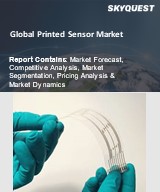
Report ID: SQMIG20D2253

Report ID:
SQMIG20D2253 |
Region:
Global |
Published Date: May, 2024
Pages:
197
|
Tables:
68 |
Figures:
75
Drivers
The automotive industry is increasingly incorporating printed sensors into vehicles for various applications such as seat occupancy detection, tire pressure monitoring, and engine performance monitoring. Printed sensors offer lightweight, low-cost solutions compared to traditional sensors, driving their adoption in this sector.
Printed sensors play a crucial role in enabling Industry 4.0 initiatives and smart manufacturing processes by providing real-time data on equipment performance, predictive maintenance, and quality control. Manufacturers are increasingly adopting printed sensor technologies to optimize production processes and reduce downtime.
Restraints
Printed sensors may have limitations in terms of sensitivity, accuracy, and response time compared to conventional sensors. These limitations can restrict their suitability for certain high-precision applications, hindering market adoption in industries such as medical diagnostics and aerospace.
The availability of suitable materials for printing functional sensor elements is limited compared to traditional sensor fabrication techniques. This constraint can restrict the performance, versatility, and functionality of printed sensors, limiting their applicability in diverse applications.
Our industry expert will work with you to provide you with customized data in a short amount of time.
REQUEST FREE CUSTOMIZATIONWant to customize this report? This report can be personalized according to your needs. Our analysts and industry experts will work directly with you to understand your requirements and provide you with customized data in a short amount of time. We offer $1000 worth of FREE customization at the time of purchase.

Report ID: SQMIG20D2253